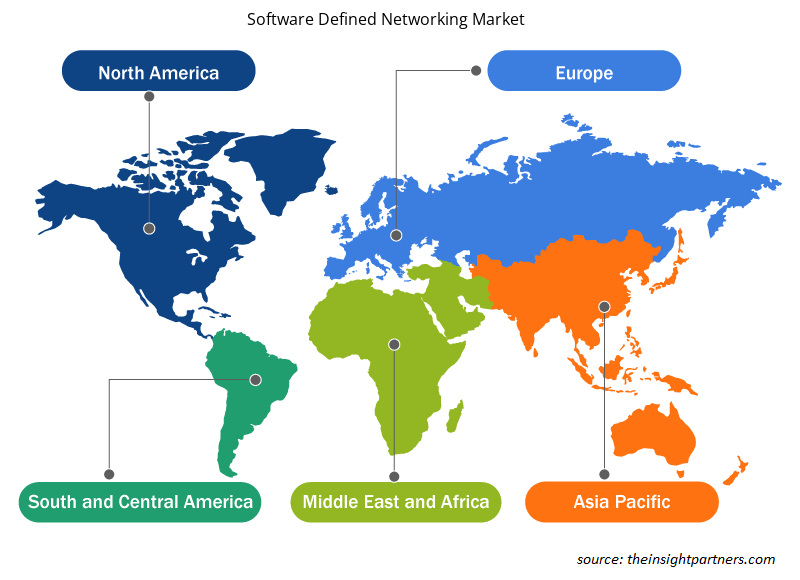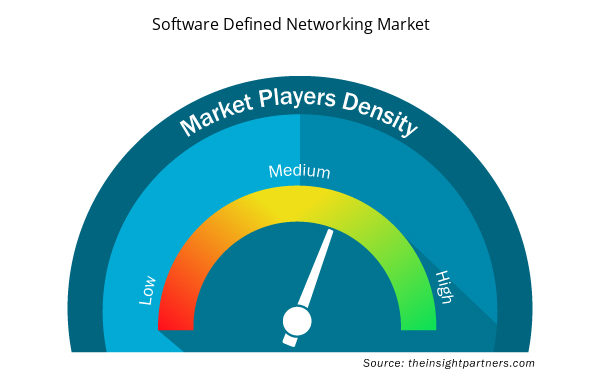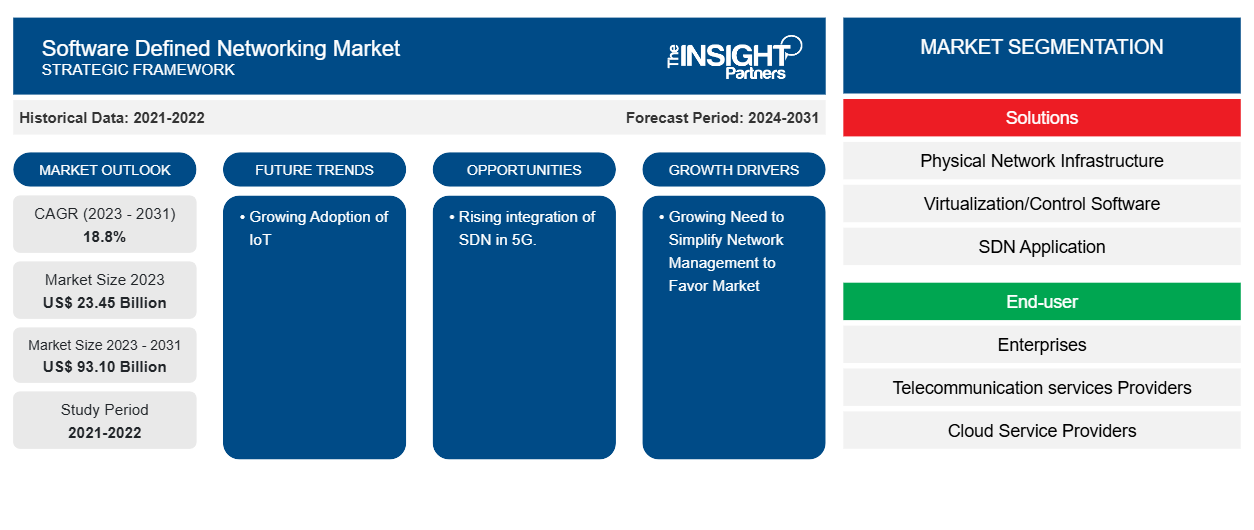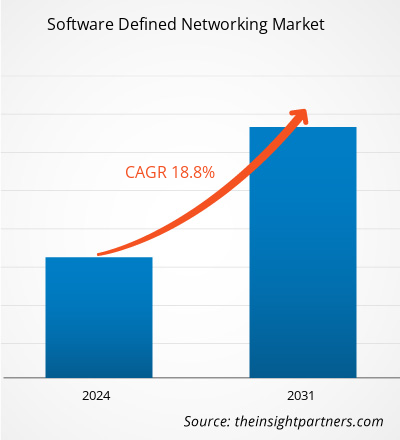ソフトウェア定義ネットワークの市場規模は、2023 年の 234.5 億米ドルから 2031 年には 931 億米ドルに達すると予測されています。市場は 2023 年から 2031 年にかけて 18.8% の CAGR を記録すると予想されています。ネットワーク管理の簡素化に対するニーズの高まりと 5G 向け SDN の実装の増加は、ソフトウェア定義ネットワーク市場の重要なトレンドであり続けると思われます。
ソフトウェア定義ネットワーク市場分析
ソフトウェア定義ネットワーク市場は急速に成長しており、IT 組織がクラウド テクノロジーに急速に移行するにつれて、市場の成長を加速させています。IT 企業や組織は、機能の効率性と回復力のために、アプリケーション レベルの役割とイベントに関連するメリットを得ています。これには、ネットワーク サービスの自動化、クラウド統合、ハイブリッド自動化サービスが含まれます。現在、いくつかの企業は、SDN 向けソフトウェア用のネットワーク サービス アプリケーションを生成して、これらのサービスがアプリケーションとその使いやすさのためにインフラストラクチャに積極的に影響を与えるようにすることで、新しい標準に仮想化の価値を追加しています。
ソフトウェア定義ネットワーク市場の概要
ソフトウェアベースのコントローラーまたはアプリケーション プログラミング インターフェイス (API) を使用して基盤となるハードウェア インフラストラクチャに接続し、ネットワーク上のトラフィックを管理するソフトウェア定義ネットワーク (SDN) は、ネットワーク技術です。このアプローチは、スイッチやルーターなどの特殊なハードウェア コンポーネントを使用してネットワーク トラフィックを管理する従来のネットワークとは異なります。SDN では、ソフトウェアを使用して仮想ネットワークを構築および管理したり、従来のハードウェアを管理したりできます。
要件に合わせてレポートをカスタマイズする
このレポートの一部、国レベルの分析、Excelデータパックなど、あらゆるレポートを無料でカスタマイズできます。また、スタートアップや大学向けのお得なオファーや割引もご利用いただけます。
- このレポートの主要な市場動向を入手してください。この無料サンプルには、市場動向から見積もりや予測に至るまでのデータ分析が含まれます。
ソフトウェア定義ネットワーク市場の推進要因と機会
市場を有利にするためにネットワーク管理を簡素化する必要性が高まる
ソフトウェア定義ネットワーク (SDN) 業界を推進する主な要因の 1 つは、企業におけるネットワーク管理の合理化に対するニーズの高まりです。従来のネットワークでは、複雑な設定や手動の管理手順が頻繁に必要となり、経費の増加や非効率を招きます。SDN は、さまざまなネットワーク デバイスを制御するための一貫したインターフェイスを提供し、ネットワーク制御を一元化し、自動化によってこれらの問題を克服します。この一元化された方法により、ベンダー中立のアプローチが促進され、ネットワークのプロビジョニングが迅速化され、ポリシー管理が簡素化され、ネットワーク パフォーマンスの可視性が向上します。SDN は、運用を簡素化して企業のコスト、時間、リソースを節約できるため、ネットワーク インフラストラクチャを更新し、変化するビジネス需要に適応するための強力なオプションです。
5G における SDN の統合の増加。
SDN は、5G エコシステム標準に準拠したインテリジェント ネットワーク アーキテクチャです。5G は SDN の助けを借りてコントロール プレーン上で動作し、フレームワーク全体を提供できます。5Gネットワークを介したデータ移動時のデータ フローの改善は、このテクノロジが提供する多くの利点の 1 つにすぎません。SDN アーキテクチャは、レイテンシを削減し、ネットワーク帯域幅を最大化します。SDN テクノロジは、最適なデータ フローをリアルタイムで識別することで、集中型コントロール プレーンからネットワークの冗長性を自動化および管理し、重大な停止を回避できます。
ソフトウェア定義ネットワーク市場レポートのセグメンテーション分析
ソフトウェア定義ネットワーク市場分析の導出に貢献した主要なセグメントは、ソリューション、エンドユーザー、展開、および業界垂直です。
- ソリューションに基づいて、ソフトウェア定義ネットワーク市場は、物理ネットワーク インフラストラクチャ、仮想化/制御ソフトウェア、SDN アプリケーション、およびプロフェッショナル サービスに分類されます。
- エンドユーザー別に見ると、市場は企業、通信サービスプロバイダー、クラウドサービスプロバイダーに分類されます。
- 業界別に見ると、ソフトウェア定義ネットワーク市場は、銀行・金融サービスおよび保険、通信・IT、消費財・小売、政府・防衛、製造、研究・学術、その他に分類されます。
地域別ソフトウェア定義ネットワーク市場シェア分析
ソフトウェア定義ネットワーク市場レポートの地理的範囲は、主に北米、アジア太平洋、ヨーロッパ、中東およびアフリカ、南米/中南米の 5 つの地域に分かれています。北米はソフトウェア定義ネットワーク市場を支配してきました。北米地域のさまざまな業界でのハイテク採用の傾向が、ソフトウェア定義ネットワーク市場の成長を後押ししています。デジタルツールの採用の増加や政府機関による技術支出の増大などの要因が、北米のソフトウェア定義ネットワーク市場の成長を牽引すると予想されています。さらに、米国とカナダの先進経済における研究開発への強い重点により、北米のプレーヤーは技術的に高度なソリューションを市場に投入せざるを得なくなっています。さらに、米国には多数のソフトウェア定義ネットワーク市場プレーヤーがおり、革新的なソリューションの開発にますます重点を置いています。ソフトウェア定義ネットワーク市場の主要プレーヤーには、IBM、Cisco、Microsoft などがあります。これらすべての要因が、この地域のソフトウェア定義ネットワーク市場の成長に貢献しています。
ソフトウェア定義ネットワーク市場の地域別分析
予測期間を通じてソフトウェア定義ネットワーク市場に影響を与える地域的な傾向と要因は、Insight Partners のアナリストによって徹底的に説明されています。このセクションでは、北米、ヨーロッパ、アジア太平洋、中東およびアフリカ、南米および中米にわたるソフトウェア定義ネットワーク市場のセグメントと地理についても説明します。

- ソフトウェア定義ネットワーク市場の地域別データを入手
ソフトウェア定義ネットワーク市場レポートの範囲
| レポート属性 | 詳細 |
|---|---|
| 2023年の市場規模 | 234.5億米ドル |
| 2031年までの市場規模 | 931億米ドル |
| 世界のCAGR(2023年~2031年) | 18.8% |
| 履歴データ | 2021-2022 |
| 予測期間 | 2024-2031 |
| 対象セグメント | ソリューション別
|
| 対象地域と国 | 北米
|
| 市場リーダーと主要企業プロフィール |
|
ソフトウェア定義ネットワーク市場のプレーヤー密度: ビジネスダイナミクスへの影響を理解する
ソフトウェア定義ネットワーキング市場は、消費者の嗜好の変化、技術の進歩、製品の利点に対する認識の高まりなどの要因により、エンドユーザーの需要が高まり、急速に成長しています。需要が高まるにつれて、企業は提供内容を拡大し、消費者のニーズを満たすために革新を起こし、新たなトレンドを活用し、市場の成長をさらに促進しています。
市場プレーヤー密度とは、特定の市場または業界内で活動している企業または会社の分布を指します。これは、特定の市場スペースに、その規模または総市場価値と比較して、どれだけの競合相手 (市場プレーヤー) が存在するかを示します。
ソフトウェア定義ネットワーク市場で事業を展開している主要企業は次のとおりです。
- シスコシステムズ株式会社
- IBM
- ヒューレット・パッカード・エンタープライズ・デベロップメント LP
- ブロードコム
- ジュニパーネットワークス株式会社
- ファーウェイテクノロジーズ株式会社
免責事項:上記の企業は、特定の順序でランク付けされていません。

- ソフトウェア定義ネットワーク市場のトップキープレーヤーの概要を入手
ソフトウェア定義ネットワーク市場のニュースと最近の動向
ソフトウェア定義ネットワーク市場は、主要な企業出版物、協会データ、データベースなどの一次調査と二次調査後の定性的および定量的データを収集することによって評価されます。市場の動向の一覧は次のとおりです。
- 2023 年 11 月、VMware, Inc. は、エッジでのデジタル トランスフォーメーションを加速するお客様を支援する新しいソリューションとパートナーシップの拡大を発表しました。最近導入された VMware Software-Defined Edge を基盤として、これらのイノベーションと新しい統合により、お客様はエッジ環境を簡素化し、セキュリティを強化し、最新化することができます。
(出典:VMware, Inc.、プレスリリース、2023年)
- 2023 年 2 月、ETSI オープンソース グループ TeraFlowSDN は、革新的で堅牢な SDN オーケストレーターおよびコントローラーである TeraFlowSDN コントローラーの 2 番目のリリースを発表しました。TeraFlowSDN Released 2 は、複数のネットワーク ドメインにわたるエンドツーエンドのトランスポート ネットワーク スライシングに対する拡張および検証済みのサポートを提供します。このリリースにより、L2/L3VPN プロビジョニング、マイクロ波ネットワーク、XR 光トランシーバーのポイントツーマルチポイント統合、および Open Networking Foundation (ONF) トランスポート API (TAPI) を介した光 SDN コントローラーとのやり取りのための SDN オーケストレーションが完了します。
(出典:ETSI、プレスリリース、2022年)
ソフトウェア定義ネットワーク市場レポートの対象範囲と成果物
「ソフトウェア定義ネットワーキング市場の規模と予測(2021〜2031年)」レポートでは、以下の分野をカバーする市場の詳細な分析を提供しています。
- 対象範囲に含まれるすべての主要市場セグメントの世界、地域、国レベルでの市場規模と予測
- 市場の動向(推進要因、制約、主要な機会など)
- 今後の主な動向
- 詳細なPEST/ポーターの5つの力とSWOT分析
- 主要な市場動向、主要プレーヤー、規制、最近の市場動向を網羅した世界および地域の市場分析
- 市場集中、ヒートマップ分析、主要プレーヤー、最近の動向を網羅した業界の状況と競争分析
- 詳細な企業プロフィール
- 過去2年間の分析、基準年、CAGRによる予測(7年間)
- PEST分析とSWOT分析
- 市場規模価値/数量 - 世界、地域、国
- 業界と競争環境
- Excel データセット


- Single-Use Negative Pressure Wound Therapy Devices Market
- Industrial Inkjet Printers Market
- Lymphedema Treatment Market
- Excimer & Femtosecond Ophthalmic Lasers Market
- Blood Collection Devices Market
- Hydrogen Storage Alloys Market
- Intraoperative Neuromonitoring Market
- Hair Extensions Market
- Medical Enzyme Technology Market
- Greens Powder Market

Report Coverage
Revenue forecast, Company Analysis, Industry landscape, Growth factors, and Trends

Segment Covered
This text is related
to segments covered.

Regional Scope
North America, Europe, Asia Pacific, Middle East & Africa, South & Central America

Country Scope
This text is related
to country scope.
よくある質問
Growing need to simplify network management organizations and rising demand for cloud services are the major factors that propel the global software defined networking market growth.
The global software defined networking market was estimated to be US$ 29.2 billion in 2024 and is expected to grow at a CAGR of 19.3 % during the forecast period 2025 - 2031.
The growing adoption of IoT and the rising implementation of software defined networking in 5G are the factors that are anticipated to play a significant role in the global software defined networking market in the coming years.
The global software defined networking market is expected to reach US$ 93.10 billion by 2031.
The key players holding majority shares in the global software defined networking market are Cisco Systems, Inc., IBM, Hewlett Packard Enterprise Development LP, Broadcom, Juniper Networks, Inc., Huawei Technologies Co., Ltd., NEC Corporation of America, Dell Inc., Telefonaktiebolaget LM EricssonCiena Corporation.
Trends and growth analysis reports related to Technology, Media and Telecommunications : READ MORE..
The Insight Partners performs research in 4 major stages: Data Collection & Secondary Research, Primary Research, Data Analysis and Data Triangulation & Final Review.
- Data Collection and Secondary Research:
As a market research and consulting firm operating from a decade, we have published and advised several client across the globe. First step for any study will start with an assessment of currently available data and insights from existing reports. Further, historical and current market information is collected from Investor Presentations, Annual Reports, SEC Filings, etc., and other information related to company’s performance and market positioning are gathered from Paid Databases (Factiva, Hoovers, and Reuters) and various other publications available in public domain.
Several associations trade associates, technical forums, institutes, societies and organization are accessed to gain technical as well as market related insights through their publications such as research papers, blogs and press releases related to the studies are referred to get cues about the market. Further, white papers, journals, magazines, and other news articles published in last 3 years are scrutinized and analyzed to understand the current market trends.
- Primary Research:
The primarily interview analysis comprise of data obtained from industry participants interview and answers to survey questions gathered by in-house primary team.
For primary research, interviews are conducted with industry experts/CEOs/Marketing Managers/VPs/Subject Matter Experts from both demand and supply side to get a 360-degree view of the market. The primary team conducts several interviews based on the complexity of the markets to understand the various market trends and dynamics which makes research more credible and precise.
A typical research interview fulfils the following functions:
- Provides first-hand information on the market size, market trends, growth trends, competitive landscape, and outlook
- Validates and strengthens in-house secondary research findings
- Develops the analysis team’s expertise and market understanding
Primary research involves email interactions and telephone interviews for each market, category, segment, and sub-segment across geographies. The participants who typically take part in such a process include, but are not limited to:
- Industry participants: VPs, business development managers, market intelligence managers and national sales managers
- Outside experts: Valuation experts, research analysts and key opinion leaders specializing in the electronics and semiconductor industry.
Below is the breakup of our primary respondents by company, designation, and region:

Once we receive the confirmation from primary research sources or primary respondents, we finalize the base year market estimation and forecast the data as per the macroeconomic and microeconomic factors assessed during data collection.
- Data Analysis:
Once data is validated through both secondary as well as primary respondents, we finalize the market estimations by hypothesis formulation and factor analysis at regional and country level.
- Macro-Economic Factor Analysis:
We analyse macroeconomic indicators such the gross domestic product (GDP), increase in the demand for goods and services across industries, technological advancement, regional economic growth, governmental policies, the influence of COVID-19, PEST analysis, and other aspects. This analysis aids in setting benchmarks for various nations/regions and approximating market splits. Additionally, the general trend of the aforementioned components aid in determining the market's development possibilities.
- Country Level Data:
Various factors that are especially aligned to the country are taken into account to determine the market size for a certain area and country, including the presence of vendors, such as headquarters and offices, the country's GDP, demand patterns, and industry growth. To comprehend the market dynamics for the nation, a number of growth variables, inhibitors, application areas, and current market trends are researched. The aforementioned elements aid in determining the country's overall market's growth potential.
- Company Profile:
The “Table of Contents” is formulated by listing and analyzing more than 25 - 30 companies operating in the market ecosystem across geographies. However, we profile only 10 companies as a standard practice in our syndicate reports. These 10 companies comprise leading, emerging, and regional players. Nonetheless, our analysis is not restricted to the 10 listed companies, we also analyze other companies present in the market to develop a holistic view and understand the prevailing trends. The “Company Profiles” section in the report covers key facts, business description, products & services, financial information, SWOT analysis, and key developments. The financial information presented is extracted from the annual reports and official documents of the publicly listed companies. Upon collecting the information for the sections of respective companies, we verify them via various primary sources and then compile the data in respective company profiles. The company level information helps us in deriving the base number as well as in forecasting the market size.
- Developing Base Number:
Aggregation of sales statistics (2020-2022) and macro-economic factor, and other secondary and primary research insights are utilized to arrive at base number and related market shares for 2022. The data gaps are identified in this step and relevant market data is analyzed, collected from paid primary interviews or databases. On finalizing the base year market size, forecasts are developed on the basis of macro-economic, industry and market growth factors and company level analysis.
- Data Triangulation and Final Review:
The market findings and base year market size calculations are validated from supply as well as demand side. Demand side validations are based on macro-economic factor analysis and benchmarks for respective regions and countries. In case of supply side validations, revenues of major companies are estimated (in case not available) based on industry benchmark, approximate number of employees, product portfolio, and primary interviews revenues are gathered. Further revenue from target product/service segment is assessed to avoid overshooting of market statistics. In case of heavy deviations between supply and demand side values, all thes steps are repeated to achieve synchronization.
We follow an iterative model, wherein we share our research findings with Subject Matter Experts (SME’s) and Key Opinion Leaders (KOLs) until consensus view of the market is not formulated – this model negates any drastic deviation in the opinions of experts. Only validated and universally acceptable research findings are quoted in our reports.
We have important check points that we use to validate our research findings – which we call – data triangulation, where we validate the information, we generate from secondary sources with primary interviews and then we re-validate with our internal data bases and Subject matter experts. This comprehensive model enables us to deliver high quality, reliable data in shortest possible time.


 このレポートの無料サンプルを入手する
このレポートの無料サンプルを入手する